Abstract
OBJECTIVE: To determine whether increased numbers of siblings and infection in early life protect against allergic sensitisation. DESIGN: Historical cohort study. SETTING: Sheffield, UK. SUBJECTS: 11,765 children aged 11-16 years for whom a history of neonatal infectious illness had been recorded systematically at 1 month of age. METHODS: A history of hay fever and family structure was obtained by postal questionnaire; neonatal illness history was ascertained from health visitor records; 723 children underwent skin prick testing with mixed grass pollen extract. RESULTS: The prevalence of hay fever was reduced (p < 0.0001) among children of younger mothers, and those from larger families. The number of older siblings exerted a stronger independent effect than the number of younger siblings (p < 0.001). Infants breast fed exclusively during the first month were at higher risk (p < 0.05) of subsequent hay fever, independent of demographic factors. Adolescents at high risk of hay fever by virtue of their family structure were more likely to be sensitised to grass pollen (p < 0.002). No significant relations emerged between hay fever and infection in the first month of life, even among children born in June. CONCLUSIONS: The association of hay fever with family structure is not due to reporting bias and reflects an environmental influence on allergic sensitisation. The effects of sibship size, birth order, and infant feeding are consistent with a protective influence of postnatal infection. The first month of life and the first postnatal exposure to allergen are not the critical periods during which this protective effect is determined.
Full text
PDF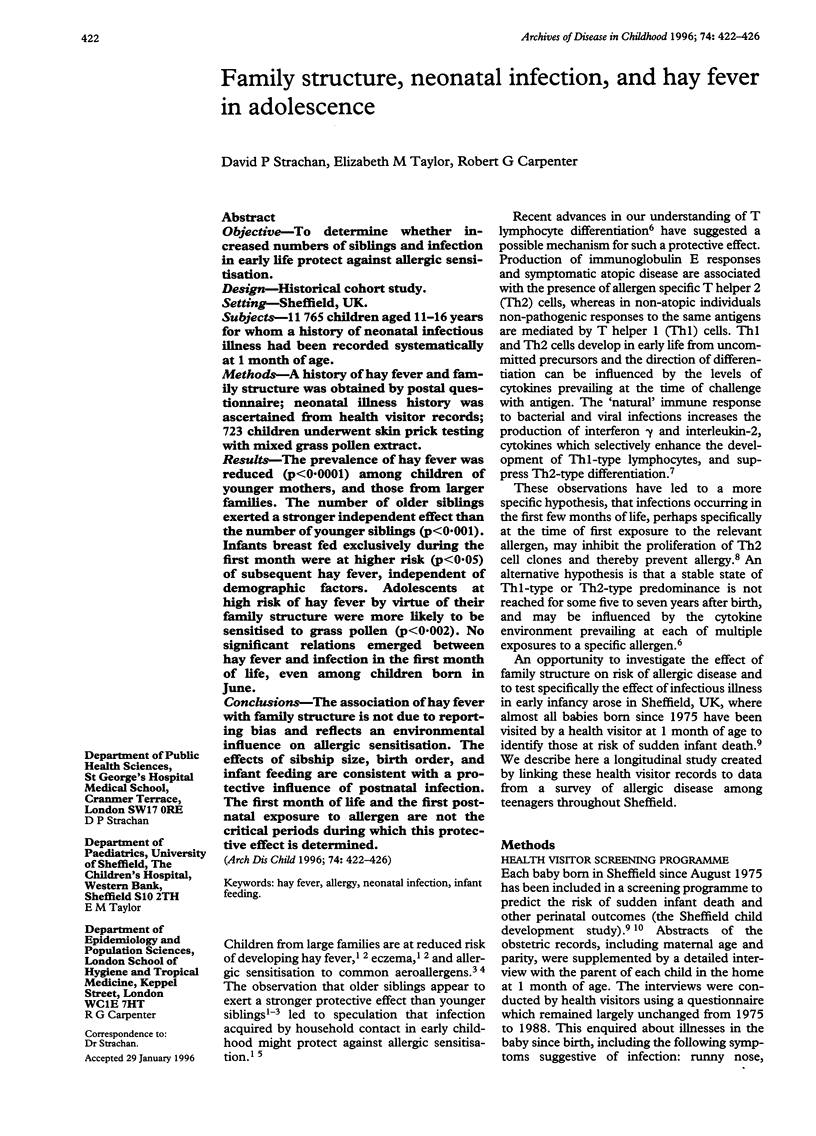
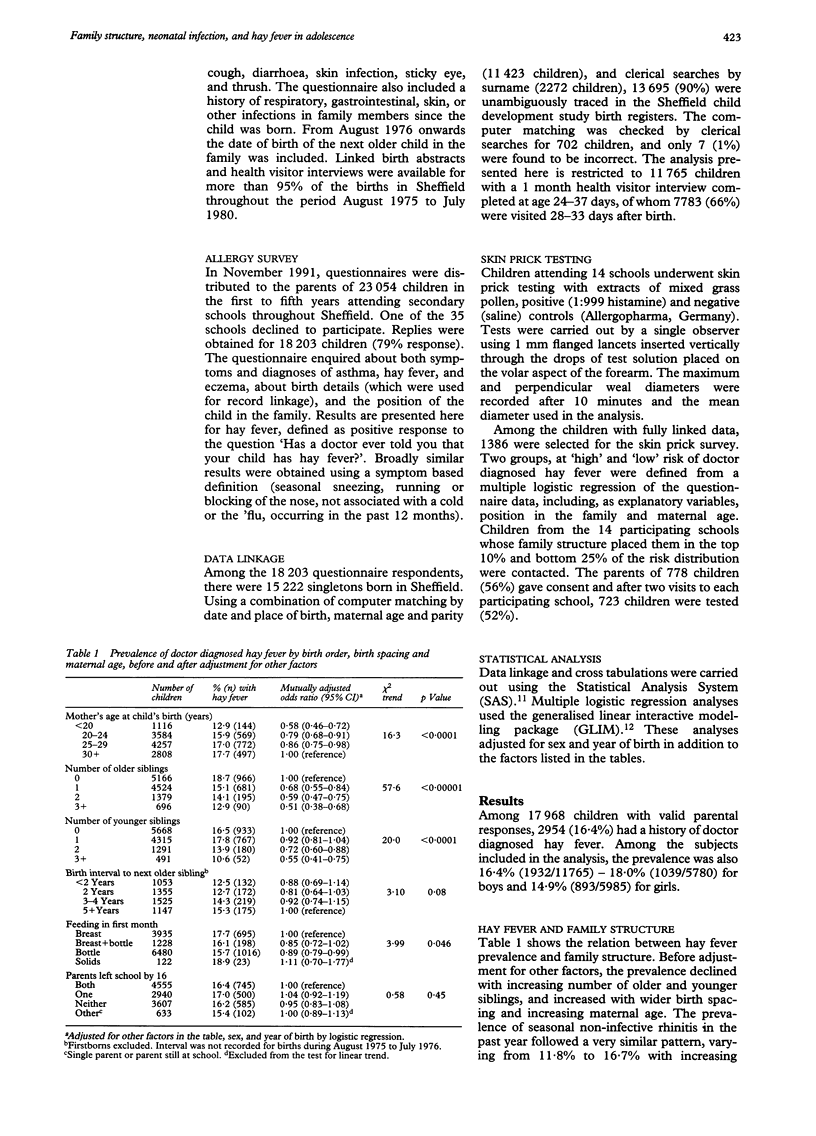
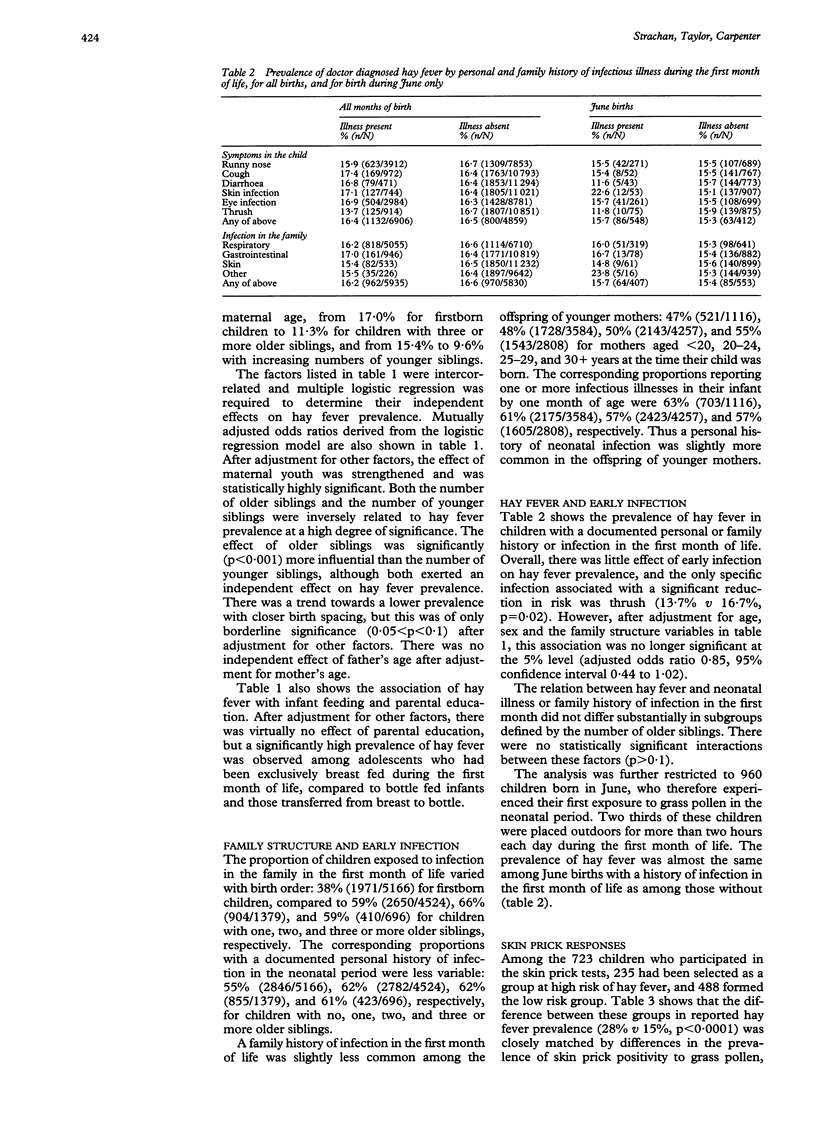
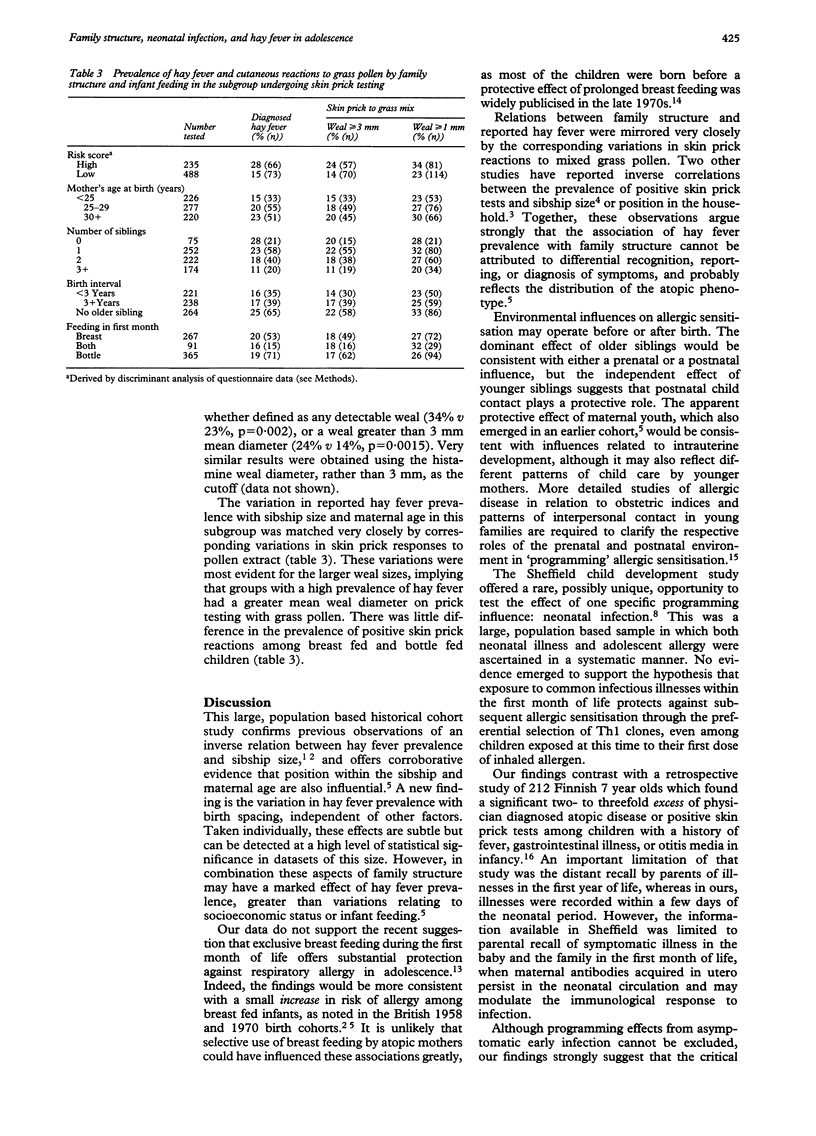
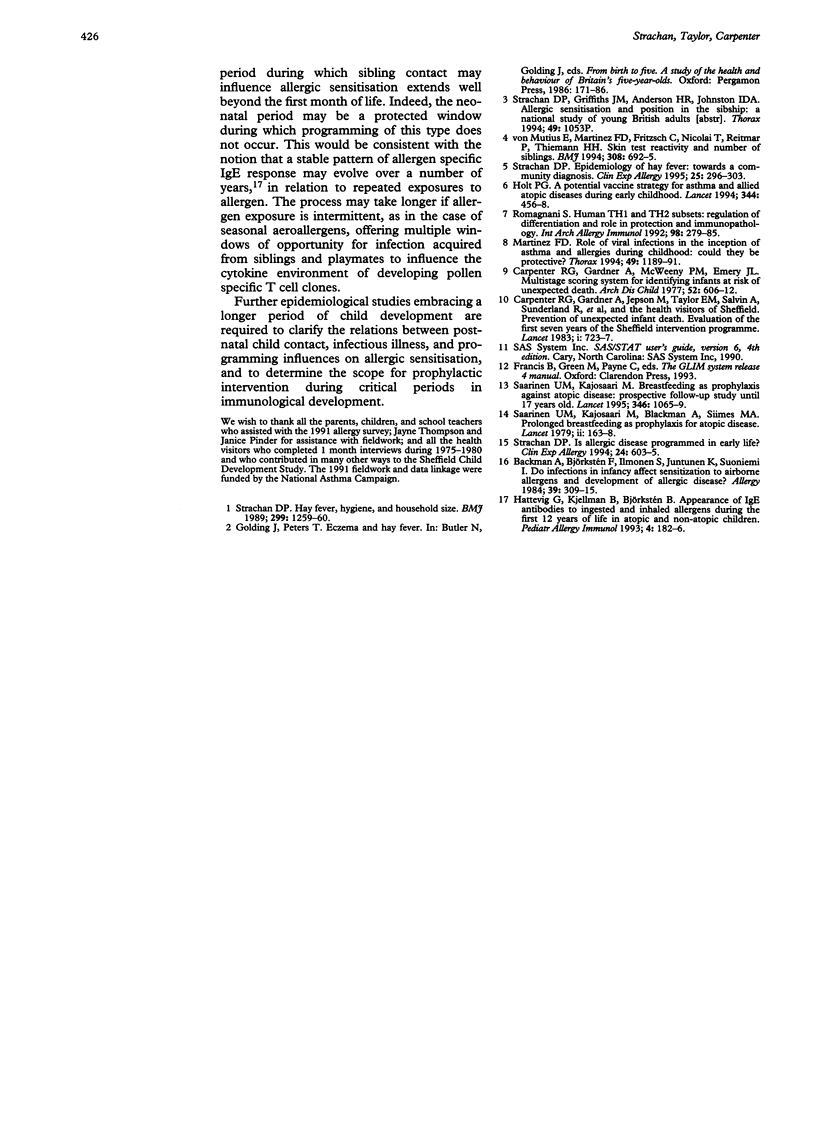
Selected References
These references are in PubMed. This may not be the complete list of references from this article.
- Backman A., Björkstén F., Ilmonen S., Juntunen K., Suoniemi I. Do infections in infancy affect sensitization to airborne allergens and development of atopic disease? A retrospective study of seven-year-old children. Allergy. 1984 May;39(4):309–315. doi: 10.1111/j.1398-9995.1984.tb00867.x. [DOI] [PubMed] [Google Scholar]
- Carpenter R. G., Gardner A., Jepson M., Taylor E. M., Salvin A., Sunderland R., Emery J. L., Pursall E., Roe J. Prevention of unexpected infant death. Evaluation of the first seven years of the Sheffield Intervention Programme. Lancet. 1983 Apr 2;1(8327):723–727. doi: 10.1016/s0140-6736(83)92023-8. [DOI] [PubMed] [Google Scholar]
- Carpenter R. G., Gardner A., McWeeny P. M., Emery J. L. Multistage scoring system for identifying infants at risk of unexpected death. Arch Dis Child. 1977 Aug;52(8):606–612. doi: 10.1136/adc.52.8.606. [DOI] [PMC free article] [PubMed] [Google Scholar]
- Hattevig G., Kjellman B., Björkstén B. Appearance of IgE antibodies to ingested and inhaled allergens during the first 12 years of life in atopic and non-atopic children. Pediatr Allergy Immunol. 1993 Nov;4(4):182–186. doi: 10.1111/j.1399-3038.1993.tb00089.x. [DOI] [PubMed] [Google Scholar]
- Holt P. G. A potential vaccine strategy for asthma and allied atopic diseases during early childhood. Lancet. 1994 Aug 13;344(8920):456–458. doi: 10.1016/s0140-6736(94)91776-0. [DOI] [PubMed] [Google Scholar]
- Martinez F. D. Role of viral infections in the inception of asthma and allergies during childhood: could they be protective? Thorax. 1994 Dec;49(12):1189–1191. doi: 10.1136/thx.49.12.1189. [DOI] [PMC free article] [PubMed] [Google Scholar]
- Romagnani S. Human TH1 and TH2 subsets: regulation of differentiation and role in protection and immunopathology. Int Arch Allergy Immunol. 1992;98(4):279–285. doi: 10.1159/000236199. [DOI] [PubMed] [Google Scholar]
- Saarinen U. M., Kajosaari M., Backman A., Siimes M. A. Prolonged breast-feeding as prophylaxis for atopic disease. Lancet. 1979 Jul 28;2(8135):163–166. doi: 10.1016/s0140-6736(79)91432-6. [DOI] [PubMed] [Google Scholar]
- Saarinen U. M., Kajosaari M. Breastfeeding as prophylaxis against atopic disease: prospective follow-up study until 17 years old. Lancet. 1995 Oct 21;346(8982):1065–1069. doi: 10.1016/s0140-6736(95)91742-x. [DOI] [PubMed] [Google Scholar]
- Strachan D. P. Epidemiology of hay fever: towards a community diagnosis. Clin Exp Allergy. 1995 Apr;25(4):296–303. doi: 10.1111/j.1365-2222.1995.tb01046.x. [DOI] [PubMed] [Google Scholar]
- Strachan D. P. Hay fever, hygiene, and household size. BMJ. 1989 Nov 18;299(6710):1259–1260. doi: 10.1136/bmj.299.6710.1259. [DOI] [PMC free article] [PubMed] [Google Scholar]
- Strachan D. P. Is allergic disease programmed in early life? Clin Exp Allergy. 1994 Jul;24(7):603–605. doi: 10.1111/j.1365-2222.1994.tb00961.x. [DOI] [PubMed] [Google Scholar]
- von Mutius E., Martinez F. D., Fritzsch C., Nicolai T., Reitmeir P., Thiemann H. H. Skin test reactivity and number of siblings. BMJ. 1994 Mar 12;308(6930):692–695. doi: 10.1136/bmj.308.6930.692. [DOI] [PMC free article] [PubMed] [Google Scholar]


